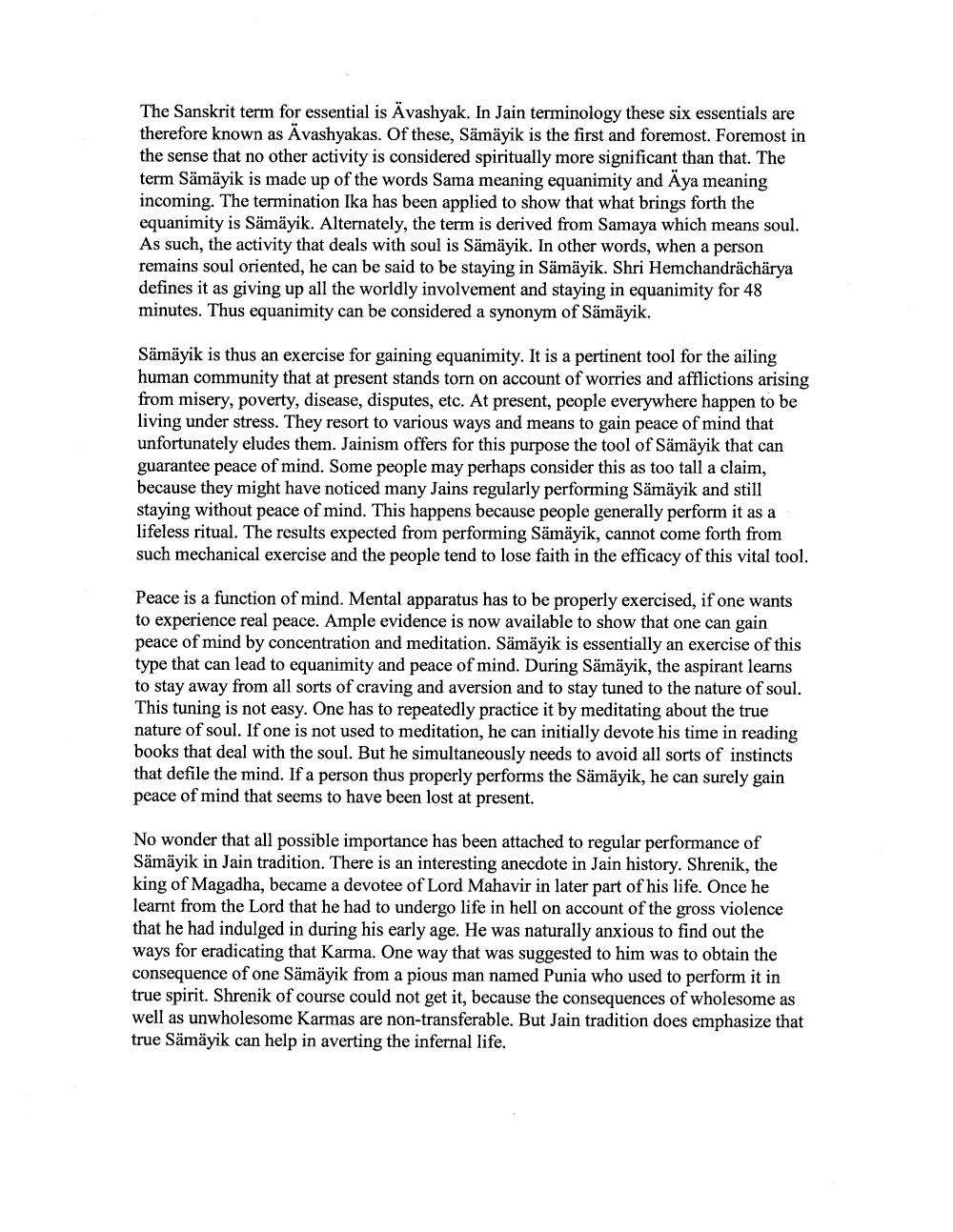________________
The Sanskrit term for essential is Ävashyak. In Jain terminology these six essentials are therefore known as Ävashyakas. Of these, Sämäyik is the first and foremost. Foremost in the sense that no other activity is considered spiritually more significant than that. The term Sämäyik is made up of the words Sama meaning equanimity and Aya meaning incoming. The termination Ika has been applied to show that what brings forth the equanimity is Sämäyik. Alternately, the term is derived from Samaya which means soul. As such, the activity that deals with soul is Sämäyik. In other words, when a person remains soul oriented, he can be said to be staying in Sämäyik. Shri Hemchandrächärya defines it as giving up all the worldly involvement and staying in equanimity for 48 minutes. Thus equanimity can be considered a synonym of Sāmāyik.
Sämäyik is thus an exercise for gaining equanimity. It is a pertinent tool for the ailing human community that at present stands torn on account of worries and afflictions arising from misery, poverty, disease, disputes, etc. At present, people everywhere happen to be living under stress. They resort to various ways and means to gain peace of mind that unfortunately eludes them. Jainism offers for this purpose the tool of Sämäyik that can guarantee peace of mind. Some people may perhaps consider this as too tall a claim, because they might have noticed many Jains regularly performing Sämäyik and still staying without peace of mind. This happens because people generally perform it as a lifeless ritual. The results expected from performing Sämäyik, cannot come forth from such mechanical exercise and the people tend to lose faith in the efficacy of this vital tool.
Peace is a function of mind. Mental apparatus has to be properly exercised, if one wants to experience real peace. Ample evidence is now available to show that one can gain peace of mind by concentration and meditation. Sämäyik is essentially an exercise of this type that can lead to equanimity and peace of mind. During Sämäyik, the aspirant learns to stay away from all sorts of craving and aversion and to stay tuned to the nature of soul. This tuning is not easy. One has to repeatedly practice it by meditating about the true nature of soul. If one is not used to meditation, he can initially devote his time in reading books that deal with the soul. But he simultaneously needs to avoid all sorts of instincts that defile the mind. If a person thus properly performs the Sāmāyik, he can surely gain peace of mind that seems to have been lost at present.
No wonder that all possible importance has been attached to regular performance of Sämäyik in Jain tradition. There is an interesting anecdote in Jain history. Shrenik, the king of Magadha, became a devotee of Lord Mahavir in later part of his life. Once he learnt from the Lord that he had to undergo life in hell on account of the gross violence that he had indulged in during his early age. He was naturally anxious to find out the ways for eradicating that Karma. One way that was suggested to him was to obtain the consequence of one Sämäyik from a pious man named Punia who used to perform it in true spirit. Shrenik of course could not get it, because the consequences of wholesome as well as unwholesome Karmas are non-transferable. But Jain tradition does emphasize that true Sämäyik can help in averting the infernal life.




